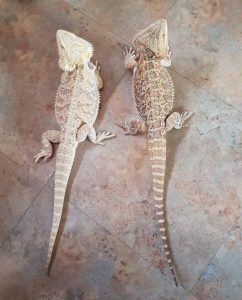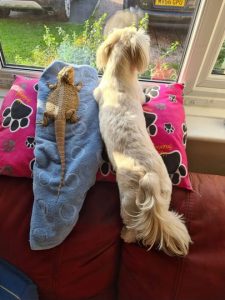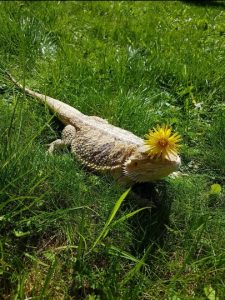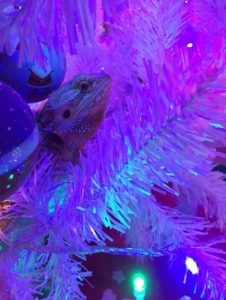
Frank Paul Silye Bearded dragon (Pogona vitticeps) Attribution-ShareAlike 2.0 Generic CC BY-SA 2.0
A mother of two bearded dragons from Eccles shares her reptile knowledge.

Brooklyn (left) and Bailey (right)
Louisa Nashir and her husband let their daughter name the dragons, with her daughter’s favorite YouTubers being Brooklyn and Bailey, [they] “knew what they would be called before we had even got them home.
“They are both females! We were unsure for a while as it’s not the easiest to sex them but when they started laying eggs, we knew both were girls.”
She says: “It is harder to know what sex they are [to other animals] as it involves lifting their tails up and using a torch shine through the base of the tail, above the vent on the tail’s topside, and look at the underside. If it’s a male, the two mentioned hemipenile bulges should be easily visible. If female, you will not see the two bulges, just the single centre bulge.
“We were confident with Bailey, but Brooklyn kept us guessing for months and even the reptile enthusiast at the local pet shop couldn’t say for sure. We now know they are both girls. Brooklyn has laid over 140 eggs and Bailey 30.”
Nashir added: “Luckily, they are not fertilized. It’s just a female Bearded Dragon thing. We take the eggs and put them in the food waste bin.”

Having 140 babies running around “would be fun and very expensive! Baby bearded dragons eat a lot of bugs whilst growing so they can be an expensive pet. As well as the heat and light needed too.
“They are great though. My Shih Tzu loves them. She adores them both. She follows them round and doesn’t leave them for a second.”
Depending on the breed, bearded dragons can grow between 16-24 inches long and by 12 months they are fully grown.
“They also love climbing! Our Christmas tree gets destroyed yearly!”
Nashir says: “They require a lot of research before buying. They [must] have the correct lighting, temperatures, what live food they will eat, what substrate you use. Many bearded dragon owners won’t use sand as the dragons can become impacted from lunging at their prey and swallowing sand. Mine prefer reptile carpet and Lino. I find it more hygienic too.
Bearded dragons eat a variety of foods, but they need live food in their diets.
“My two love locusts! They are alive fed once a week now they are fly grown and fed daily with fruits and vegetables. Their favorites are rocket, peas, blueberries, and strawberries”.

Nashir lets her them out for a ‘few hours’ during the summer as they ‘love to bask in the sunlight’.
“Now it’s getting colder we tend to [let] them out for short periods of time, [due to them being] “cold blooded so need the heat and light to keep them well.”
Her advice on people that are thinking of adopting or buying a reptile would be to “research them properly and remember that they are a big commitment. They are extraordinary animals and very rewarding.”
Each year on October 21st, people across the nation observe National Reptile Awareness Day.
The awareness day has been created not only for reptile lovers but to help promote education, conversation, and appreciation for reptiles.
Today is a day to learn about the reptile’s natural habitats and the threats that they are currently facing.

A reptile is any amniote that is neither like a mammal nor a bird, is cold-blooded, has scales and can lay eggs on land. There are more than 10,000 species of reptiles and the day promotes the wide varieties, their habitats, and how we can benefit from reptiles.














Recent Comments